Only 30 years ago, Blue-throated Macaw, an endemic to the Beni savannahs of Bolivia, was feared extinct. However, a wide-ranging conservation programme by Asociación Armonía (BirdLife in Bolivia) is beginning to change the fortunes of this enigmatic parrot.
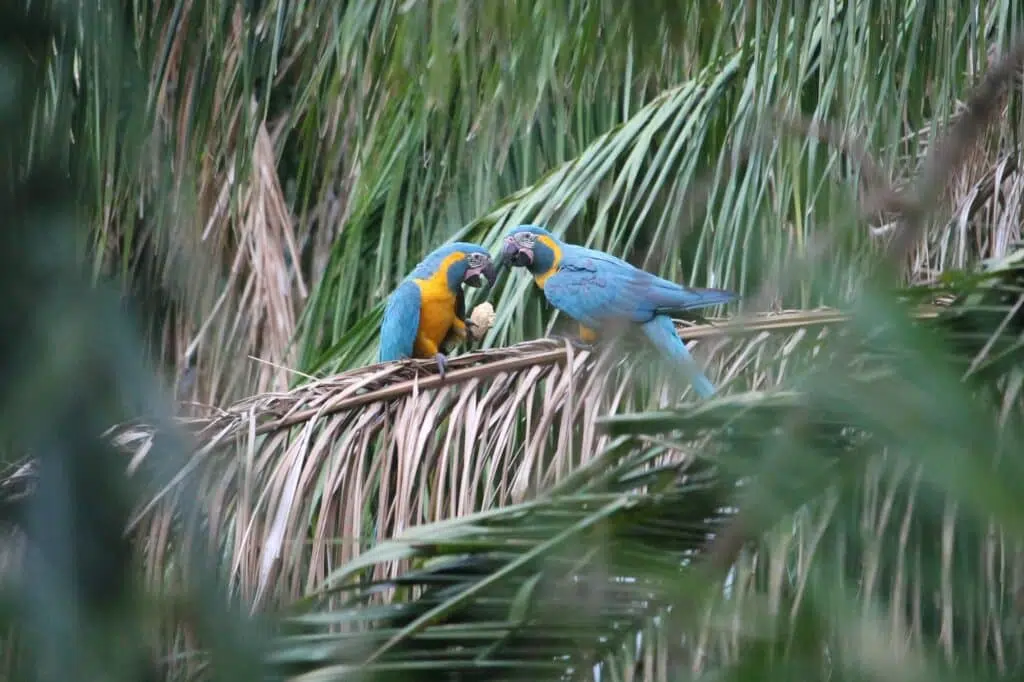
A young Blue-throated Macaw peers out of its nest and tilts its head, before taking a leap and spreading its wings for its first flight over Bolivia’s Beni savannah. However, rather than appearing from a natural hole in a tree, this fledgling has emerged from one of the numerous man-made nest boxes that Asociación Armonía has erected as part of a large-scale programme to save this Critically Endangered species.
When the last wild Spix’s Macaw disappeared in 2001 from the Caatinga forests of neighbouring Brazil, it was not beyond the realms of possibility that Blue-throated Macaw would soon follow suit. At the time, this endemic of the Beni savannahs of north-west Bolivia was thought to number as few as 100 birds, with decades of habitat degradation and capture for the lucrative pet trade driving the species to the brink of extinction.
In fact, scientists had previously feared that the species was already extinct until it was rediscovered in 1992. Within a few years, Asociación Armonía began a programme to protect the species. Much of its early work focussed on finding out more about this poorly known species, which until the 1970s even world-leading parrot experts suspected was only a subspecies of the closely related yet widespread Blue-and-yellow Macaw – one of the key distinguishing factors being its eponymous turquoise throat. This was no easy feat, given that the species occurs in three small distinct sub-populations in one of Bolivia’s most remote regions, where grasslands flood for eight months of the year as heavy rains merge with rivers flowing from the nearby Andes.
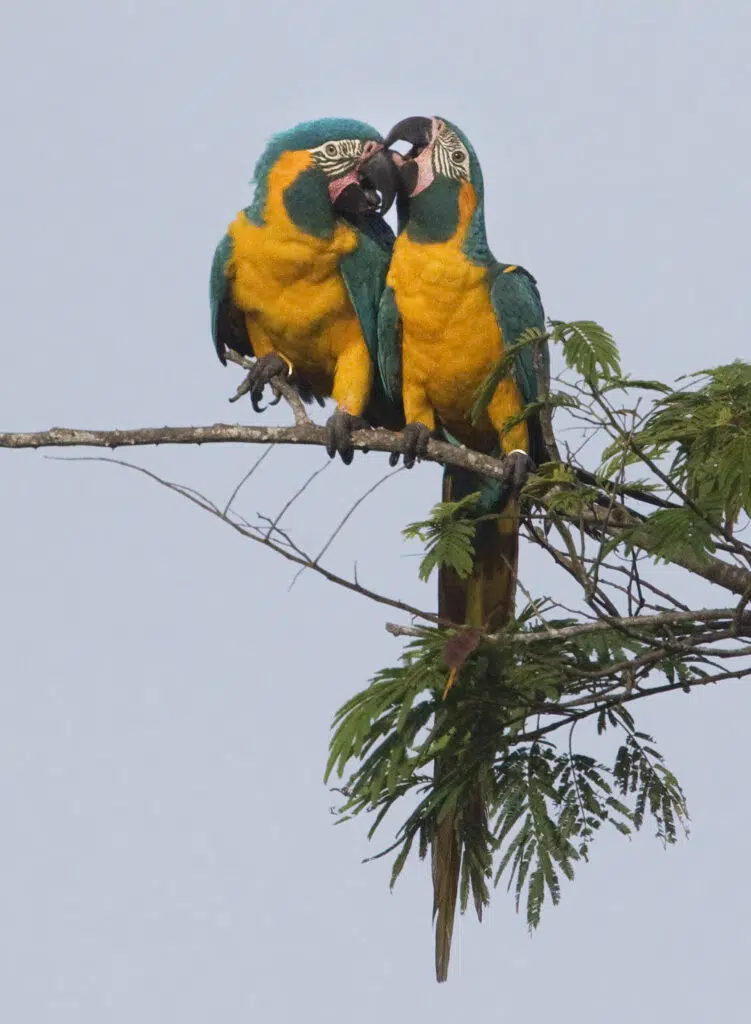
Successive campaigns to raise the profile of the macaws helped reduce capture for the pet trade. However, the species was still frequently hunted by the Moxeño – an indigenous people of Bolivia – who use the tail feathers from four macaw species to adorn elaborate headdresses worn by macheteros (dancers) at festivals. Each of these impressive headdresses uses 30 tail feathers, and given that macaws only have two, a single garment requires 15 macaws. With more than 100 macheteros often dancing at a single festival, the number of dead macaws adds up rapidly.
Asociación Armonía soon came up with a solution – headdresses using fabric that mimics macaw feathers. To spread word of this innovative idea, it ran a competition across the Beni, awarding a cash prize to whoever made the most impressive headdress using alternative feathers, and the idea quickly caught on. Combined with awareness-raising programmes, and aided by the deep sense of guardianship the Moxeño people feel towards Beni’s wildlife, 95% of headdresses in the region now use alternative feathers.
Since 2010, the project has saved more than 6,000 macaws, while also creating a new livelihood for the communities, who frequently sell these alternative headdresses to tourists.
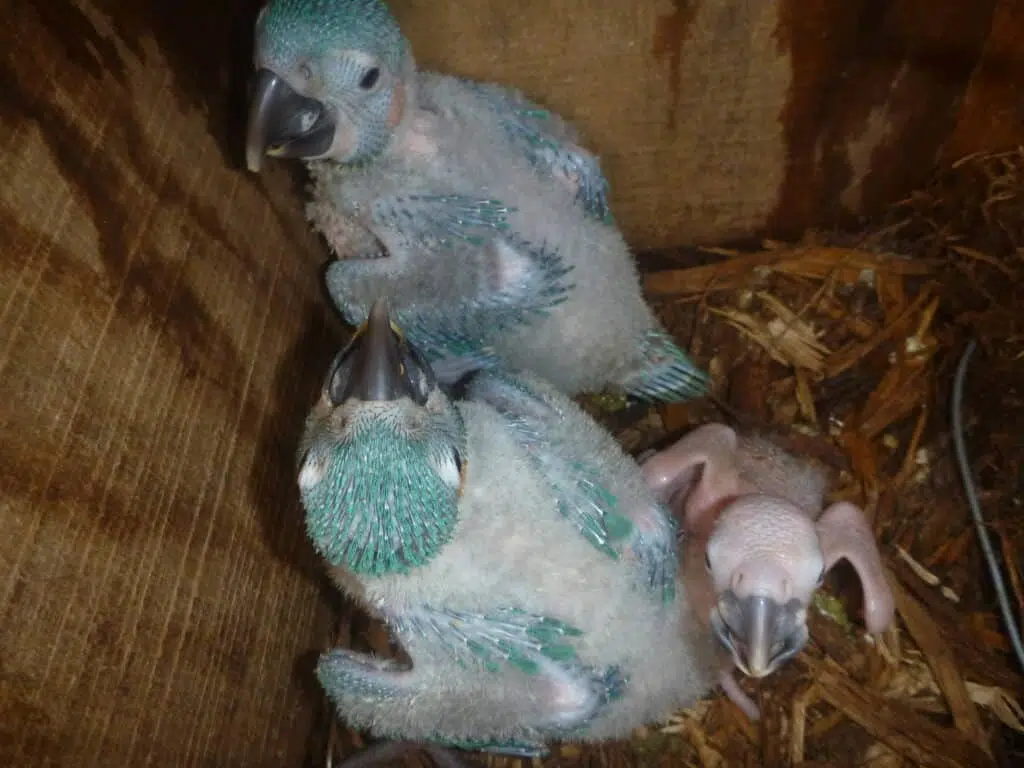
Three Blue-throated Macaw chicks in a nest box installed in the Laney Rickman Reserve © Asociación Armonía
Nest boxes to protected areas
Another of the organisation’s oldest projects is the nest box programme. Blue-throated Macaws naturally nest in the cavities of large, old-growth trees, now scarce across Beni following 150 years of intensive ranching. Suspecting that a dearth of nest cavities may be limiting the species’ breeding success, Asociación Armonía installed 20 nest boxes across private ranches as an experiment in 2005.
Within a year, all 20 boxes were used – albeit just one by Blue-throated Macaws – confirming suspicions that natural nest holes were in short supply. The organisation quickly scaled-up the programme and now regularly erects more than 100 nest boxes annually, and over the last 15 years this has helped 113 young Blue-throated Macaws to fledge. Given that the latest official population census estimated there are just 455 Blue-throated Macaws remaining in the wild, this represents a sizeable proportion of the macaws flying free across the savannahs.
In 2018, when 680ha of land where large numbers of macaws frequently bred went up for sale, the organisation bought it and established the Laney Rickman Blue-throated Macaw Reserve – the second private protected area it manages in Beni. “We are now working to restore the area’s degraded forests in the hope that the macaws will be less reliant on man-made nest boxes in the long term,” says Luz Natalia Mercado, Asociación Armonía’s Blue-throated Macaw Programme Co-ordinator.
“This is why I love conservation. You try something out, work out what’s going on and build from there,” says Tjalle Boorsma, Conservation Programme Director at Asociación Armonía. “From what started as a small experiment, we are now protecting the largest known breeding population of a Critically Endangered species.”
Ranching for conservation
The older of the two private areas that Asociación Armonía manages is the 11,000ha Barba Azul Nature Reserve – named after the Spanish name for the species, which translates to ‘blue beard’. Established in 2008, the reserve protects the largest non-breeding population of Blue-throated Macaws on Earth.
The reserve is split into two, with 6,000ha managed as a conventional nature reserve. Here, native vegetation – such as Motacú palms, the macaws’ main food source – is left to regenerate naturally following years of overgrazing and annual burning. Since establishing the area, the number of Blue- throated Macaws has steadily increased, and in July 2022, 228 birds were seen roosting at a single forest island [see below] – a new record and over 60% of the global wild population.
Although established to protect the Critically Endangered macaws, the reserve also conserves vital habitat for more than 340 bird species, including Greater Rhea, Streamer-tailed Tyrant and Orinoco Goose. It’s also home to a stellar cast of mammals, from Pumas and Maned Wolves to Giant Anteaters and Bush Dogs. This rich biodiversity, combined with its stunning, panoramic landscapes, makes Barba Azul ideally suited to ecotourism, an activity that Asociación Armonía is in the process of developing.
The other half of the reserve is used for sustainable ranching – something that may surprise those versed in environmental issues. Why would conservationists farm animals so closely associated with ecological destruction and climate catastrophe? Indeed, this is the reaction Asociación Armonía often faces. However, unlike the Amazon rainforest, the “Beni savannah is an ecosystem compatible with cattle,” says Luz. “In fact, given that the area is now devoid of the ancient megafauna that once roamed these plains, if managed correctly, cattle can perform similar ecological roles”.
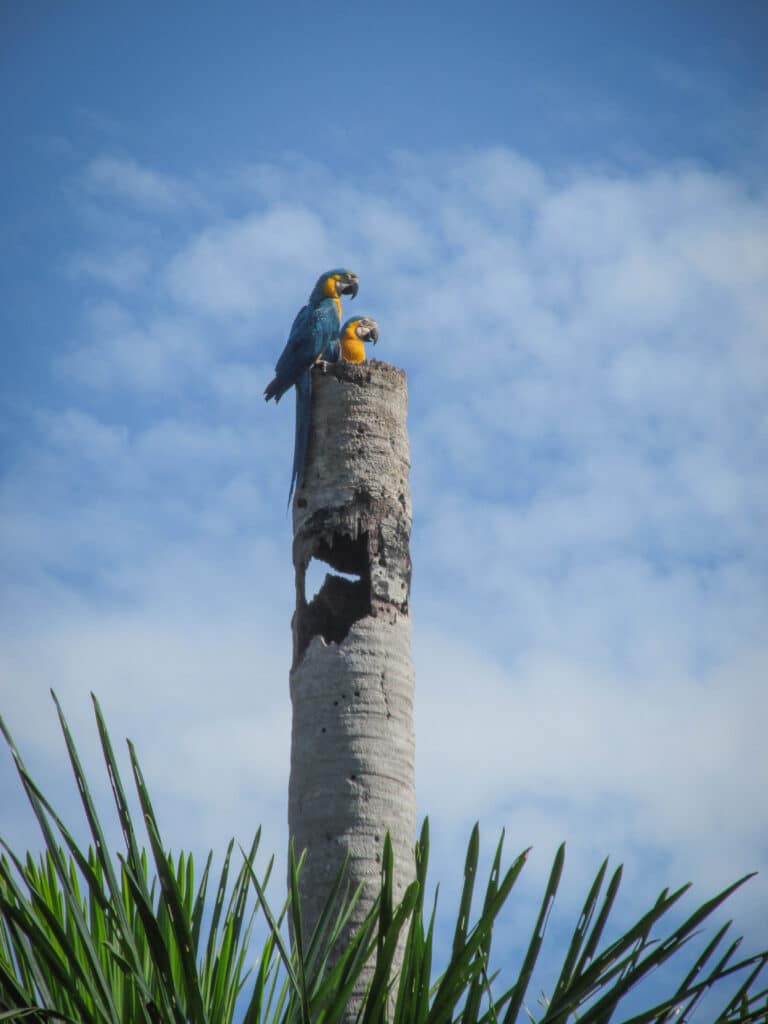
Blue-throated Macaws choose natural nest sites in the cavities of large, dead palm trees © Tjalle Boorsma/Asociación Armonía
By using sustainable techniques and fencing off crucial forest islands dotted throughout the grasslands, the organisation maintains habitat for the savannah’s biodiversity – including vital habitat for grassland species such as Cock-tailed Tyrant and Black-masked Finch – while also producing eco-friendly beef. The profits are then used to help support the running costs of managing a large nature reserve.
However, outside the reserve, years of overstocking, overgrazing, annual burning and planting of exotic African grasses has resulted in the Beni savannah becoming a highly threatened ecosystem. Threats to the landscape are compounded by a new form of agriculture that the Bolivian government has been promoting in Beni – soya and rice farming, which could practically strip the landscape of its rich diversity.
Asociación Armonía therefore works closely with ranchers outside the reserve to try and encourage them to use more environmentally friendly techniques and veer away from potentially destructive forms of agriculture. However, profits are ultimately important, and “we are now experimenting with ways to increase the profitability of our eco-ranch, in the hope that it can be used as a model for other ranchers to follow suit,” explains Boorsma.
Solving the puzzle
Protecting the wider landscape is especially important for the north-western population of Blue-throated Macaws in Barba Azul. Unlike the southern population in Laney Rickman Reserve, these macaws only congregate in the reserve during the dry season, before migrating out to breed (despite many attempts to get them to breed in nest boxes within the protected area). “For over a decade, where these birds were going was a complete mystery, and one critical to solving for their protection”, says Bennett Hennessy, Development Director for Asociación Armonía.
The species’ breeding season coincides with Bolivia’s wet season, when much of the remote and flooded savannahs are only accessible on horseback, making surveys challenging. Over the years, Asociación Armonia has received numerous calls from private ranchers who were convinced they had seen a Blue-throated Macaw on their property, but these always ended up being Blue-and-yellow Macaws. However, much to the surprise of the team, an expedition following another tip-off in 2016 got their first glimpse of a wet season ‘north-western’ Blue-throated Macaw.
A further five birds were seen the next year, when they were also observed breeding. Despite this exciting development, an exceptionally wet rainy season meant that the next full expedition could not take place until 2020. That year, three teams covered over 300 km on horseback, and approximately 100 of the Critically Endangered macaws were found breeding across 14 private ranches – nesting in palm species not found in Barba Azul.
That same year, researchers also managed to GPS-track three macaws – after years of trying to tag the unco-operative birds – and the results confirmed these were indeed the same macaws as in the reserve. Finally, the mystery had been solved.
Excitingly, these expeditions also discovered several Blue-throated Macaws at a site too far north to have come from Barba Azul, raising suspicions that there may be another, as yet unknown, sub-population. This is potentially another sign that the species, once on the precipice of extinction, is now heading in the opposite direction to its Brazilian cousin 20 years ago – and without the usual reintroduction programmes often touted for endangered macaws.
“Given that almost every year we report a record number of Blue-throated Macaws, it is clear this species’ north-western population is increasing,” says Rodrigo Soria Auza, Asociación Armonía’s Executive Director. “This is also the case for its southern population, where over 100 fledglings born in our artificial nestboxes have been recruited into its wild population. We are very confident that the wild population is increasing.”
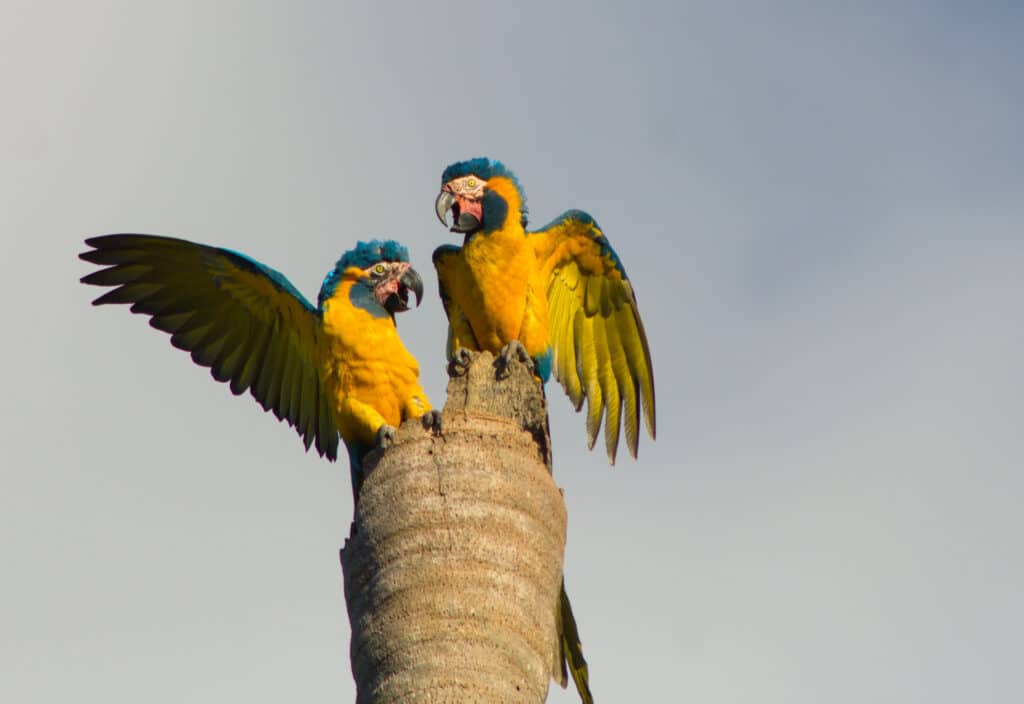
A pair of Blue-throated Macaws on a dead Moriche palm, a tree species not found in Barba Azul Nature Reserve © Tjalle Boorsma/Asociación Armonía
source: https://www.birdlife.org








